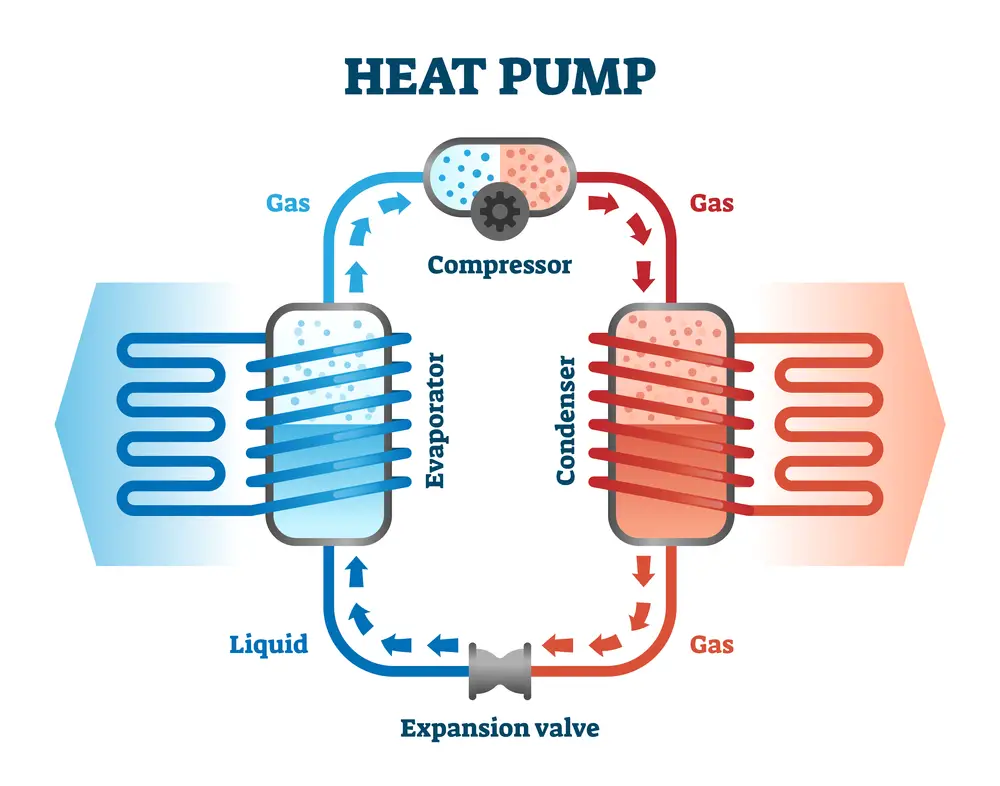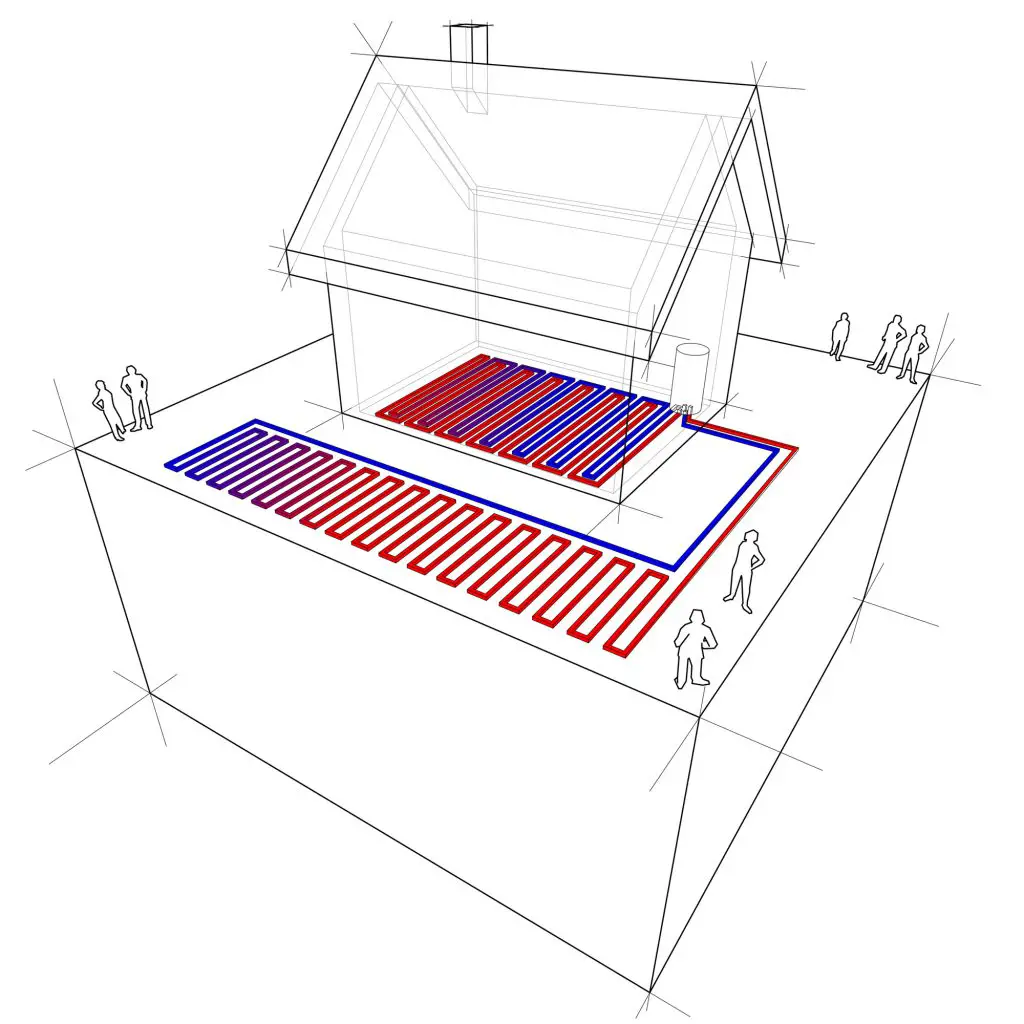Upon installing ground source heat pumps, one must consider the good and the bad it does to the environment. Extensive research must be carried out about the suitability of the land and its environs by qualified professionals; this is to prevent catastrophic situations.
A well-designed geothermal heat pump system presents so many benefits that help to maintain a green, comfortable, and healthy environment. This system helps to reduce carbon emissions, noise pollution, and energy usage. It also helps to increase the value of homes.
| Environmental Advantages | Environmental Disadvantages |
| Use of renewable energy (solar warming of the earth) | Energy Intensive Installation |
| Year-round warming availability | Require mains energy to run (can be run from renewable sources) |
| Compressors usually inside the home (less noise pollution) | Uneven ground temperatures |
| No carbon emissions (barring mains energy use to run the heat pump) | Landscape alteration |
| Highly efficient (see below) | Small risk of groundwater contamination |
However, this system also poses some threats to the environment upon installation. The perks of a ground source heat pump greatly outweigh its shortcomings. These shortcomings can be easily avoided if the system is well designed. The gravity of these shortcomings on the environment could be very severe if proper measures are not taken against them.

How do ground source heat pumps work, and how do they connect to underfloor heating systems?
A ground source heat pump uses thermal energy captured from the ground, which is then used to heat a building. In order to transfer heat from the ground beneath your garden, underground pipes are laid out in either a horizontal array or inside a deep vertical borehole.
Due to the relatively constant temperatures below the surface, a ground source heat pump system can be used all year round. An underground pipe network, also known as a ground array or ground loop, is laid approximately 1.2 meters under the surface (in a horizontal array) and is filled with a mix of antifreeze and water.
Solar energy is absorbed and stored in the ground all year round, the pipes laid beneath the soil absorb this heat and the fluid running through them warms up. The fluid runs through the pipe system and back to a control hub inside the home. The control hub then uses expression and contraction technology to efficiently extract this heat from the pipe fluid, which then continues to circulate around the array.
The warmed water will then circulate into a heat-emitting system within the home, for example, underfloor heating or radiators.

Ground-source heat pumps generate heat based on the length of the ground loop. If your house is bigger, you’ll need a longer ground loop.
In addition to providing a buffer of stored hot water for the underfloor heating system, it also reduces the cycling of the GSHP. The buffer tank usually has a section for producing hot water at the top, along with connections for connecting solar panels and/or other heat sources.
What is the impact on the local environment when a ground source heat pump is installed?
The environmental impact of the installation of ground source heat pumps could be very severe if the system is not well-designed. The possible impact of this system includes the following:
- Groundwater Contamination: When there is a leak in the pipes carrying water or refrigerant for the system, there would be contamination of groundwater. This is due to the nature of the refrigerant or the water in the pipes. The water in the pipes contains antifreeze which is made up of chemicals such as ethanol, methanol, and propylene glycol, to prevent the water from freezing in extreme weather conditions. Also, if the type of refrigerant used in the system contains hydro chlorofluorocarbon(HCFC), such as R404a and R22, the system would need to be modified due to their impact on groundwater, and the ozone layer. Modern-day systems now make use of R410A since it evaporates immediately when it leaks from pipes. It is non-toxic and causes no contamination to groundwater.
- Uneven ground temperatures: This is due to the ground not being able to recover the heat lost to the property. When this occurs, it could create unstable ground scenarios like ice lenses and permafrost. The ground loops would need to be spread across a larger surface area, to ensure the heat source is large enough to meet the heating demands.
- Landscape Alterations: Since the floor would need to be dug to fit in the pipes, it could lead to permanent alteration of the landscape. Upon covering the pipes, the excess sand would have to be moved elsewhere. Also, trees would need to be moved away from that area, to prevent their roots from interacting with the pipes. This digging could also make the land susceptible to earthquakes.
How do Ground Source Heat Pumps Use and Produce Energy?
Geothermal heat pumps comprise a network of pipes buried underground to harness thermal energy. The ground collectors, as you may call the underground network, can be buried either vertically or horizontally. If the land is sufficient, horizontal installations are the most cost-effective and indeed, the most popular.
The typical geothermal heat pump features three components: Heat pump, heat exchanger, and distribution system. The pipes in the distribution system carry brine, better known as the antifreeze solution. The solution is colder than the surrounding ground to enable heat transfer from the ground to the heat pump system.
Just a few feet underground, the temperature largely remains constant throughout the year despite the temperature variations on the surface. The temperature at this depth(10ft) is usually between 50 to 60°F (10 to 16°C).
How energy-intensive is the installation?
Installation of a geothermal heat pump is a highly energy-intensive process given the magnitude of equipment that must be placed underground. Drilling and groundwork using powerful machines can take several days to set up the system, thereby using a lot of energy.
The installation cost may be relatively high because of the activities involved. It would be best to employ the services of a certified professional to carry out the installation; this is to ensure the system is well installed.

How efficient are ground source heat pump systems?
A modern ground source heat pump system can achieve an efficiency of up to 400% but could fluctuate due to ground temperatures. In other words, if your geothermal heat pump has this level of efficiency, it can deliver 4 units of cooling/heating (CoP of 4) from 1 unit of electricity.
The efficiency of a ground source heat pump is based on its CoP (Coefficient of performance). The higher the CoP of the heat pump, the lower the amount of input energy it will need to run.
Can geothermal heat pumps be considered renewable energy?
In general terms, geothermal heat pumps can be considered renewable energy because the energy that these pumps rely on is inexhaustible. If you could run the pump from electricity derived from a renewable energy source, then the system becomes carbon-neutral too.
Connection to Renewable Energy Basics
The main feature of any renewable energy source is that it doesn’t run out. Solar energy trapped underground is renewable. Geothermal heat is also inexhaustible. Geothermal heat pumps use these two sources of thermal energy.
What others say
The ground source heat pump may be growing in popularity, but its recognition as renewable energy is still limited. Some people cite the fact that the pump runs on electricity generated from fossil fuels. However, this only makes the system lose the carbon-neutral tag. If you ran the heat pump from a renewable source such as solar power, and offset the energy cost of installation, then the system would be considered a lot more green.

Potential advantages of ground Source Heat Pumps to the environment.
The benefits of ground source heat pumps include the following:
- Carbon Emissions: Ground Source heat pumps do not produce any carbon emissions on their own compared to conventional boilers. These boilers make use of fossil fuels, which emit greenhouse gases that contribute to global warming. Ground source heat pumps are green, healthy, and do not contribute to the carbon footprints. A study by William Ryan and his researchers showed that ground source heat pumps produce less carbon dioxide emission reduction per unit investment than converting to a high-efficiency furnace.
- Noise Pollution: The fact that the compressor of this system is situated far away ensures the system does not generate noise. Air source heat pumps are noisy during operation as a result of the outdoor compressor and can be very disturbing to the homeowner and possibly neighbors.
- Low energy use: Ground source heat pumps are more energy-efficient than other heating systems. The energy saved when using this system can be diverted to other uses, and can also help reduce electricity demand.
Aside from environmental advantages, installing a ground source heat pump is likely to lead to an increase in property value. The fact that other houses in that area do not have this system also contributes to its increase in value.
Grants
There are grants to promote the uptake of geothermal heat pumps. In a place like the UK, geothermal heat pumps attract grants that can help recoup some of the installation cost. Applications for the renewable heat incentive run until 31 March 2022, beyond which new applicants will be turned back.
The grant aims to reduce the installation cost burden. The Office of Gas and Electricity Markets (Ofgem) bases its intervention on the amount of renewable energy a property generates.
Every ground source heat pump system is unique
Quoting the exact environmental cost of the installation is difficult because every project is unique. Experts will tell you that the biggest cost determinant is the system type. The size of the system is also worth considering.
Larger installations require extensive excavations and larger distribution systems. Regardless of the environmental cost that you incur during installation, this system should offer financial payback within a few years. Not only are the financial benefits tangible, but there is the added advantage of increased property resale value.

Conclusion – Main Environmental Considerations when installing a ground source heat pump
The environmental impact of installing geothermal heat pumps can be avoided if the system is well-designed. Before installing this system, proper research must be done on the land to ensure it is suitable for the project. The advantages of installing this system greatly outweigh the negatives if the system is well installed.
Geothermal heat pump installations may pose a risk to groundwater if there are leaks in the system. Avoid poor quality grouting during installation to prevent the formation of preferential pathways for pollutants. Proper sizing of the ground loops must be observed to prevent thermal imbalances in the ground.
Geothermal heat pumps ensure a clean, healthy, and green working environment. They generate no carbon emissions of their own. Although they are not fully considered “green” since they rely on electricity which could be gotten from fossil fuels. The system could be paired with a renewable energy source to ensure there are no carbon emissions.
